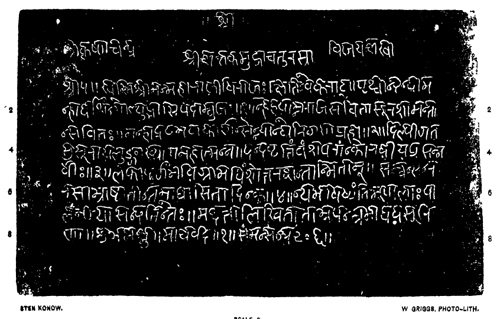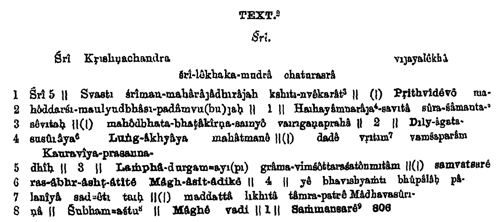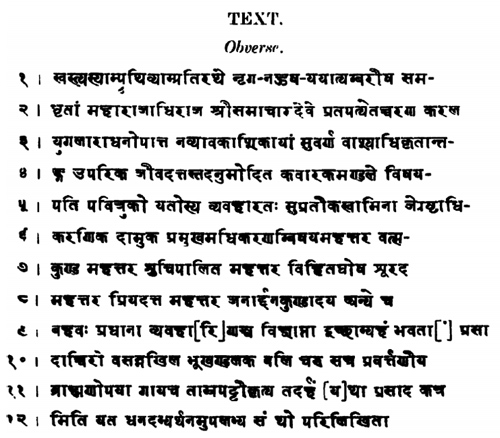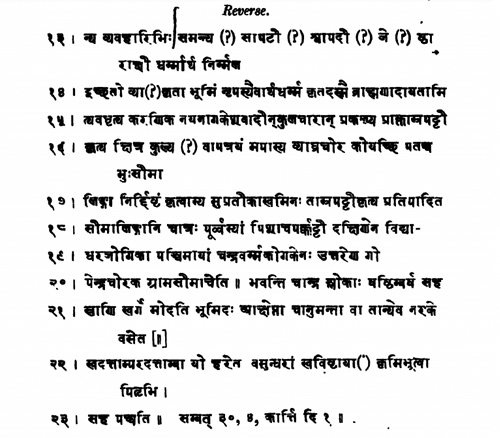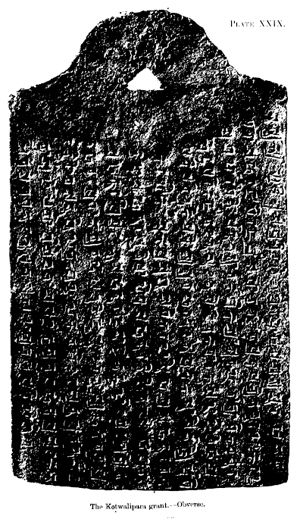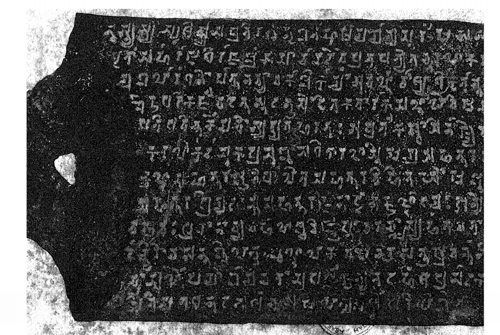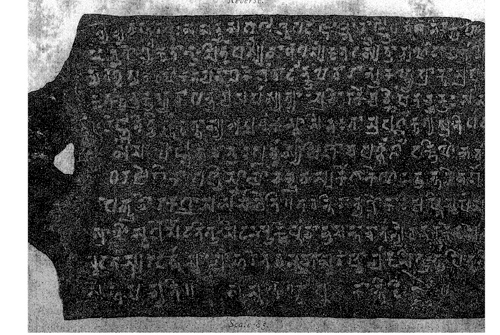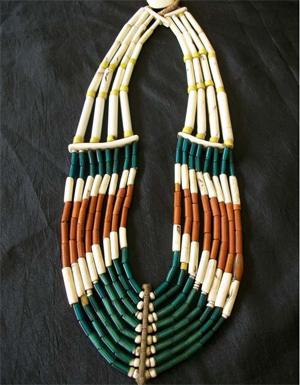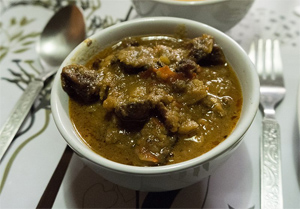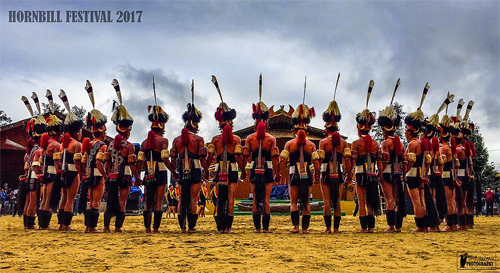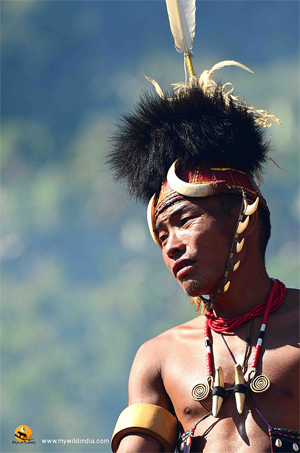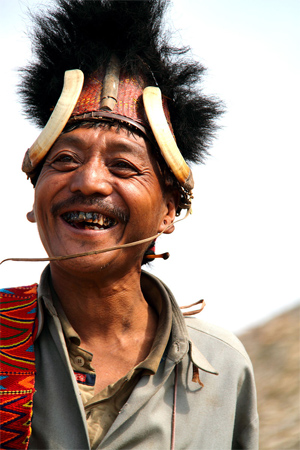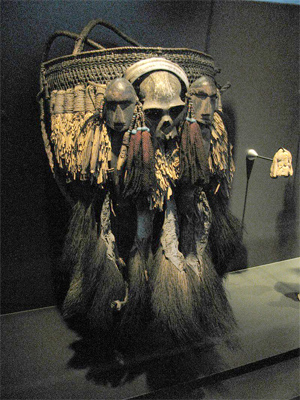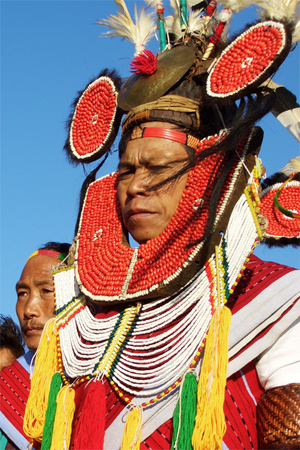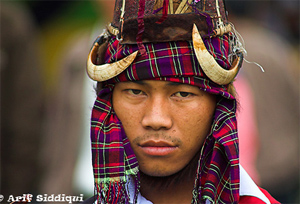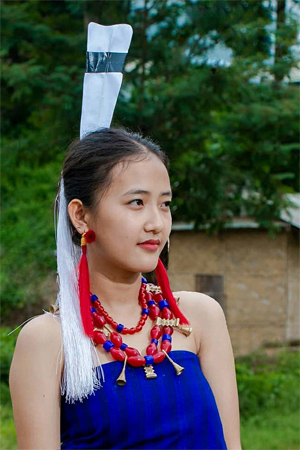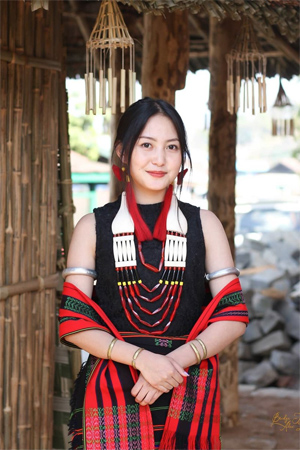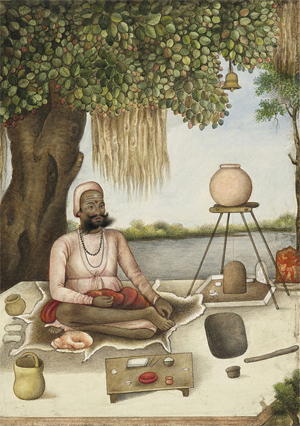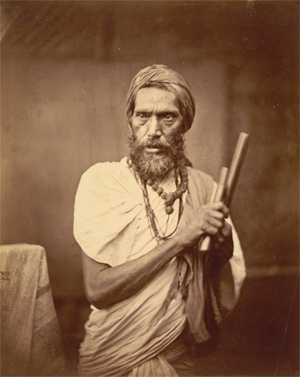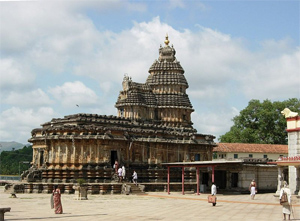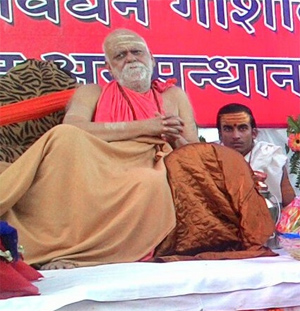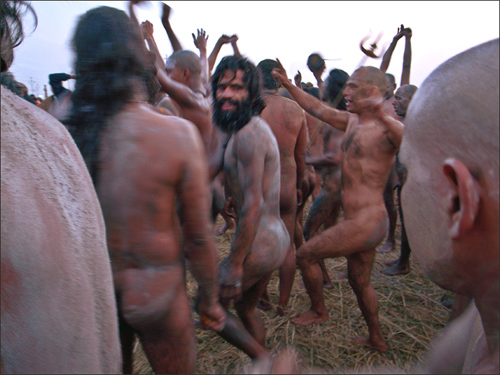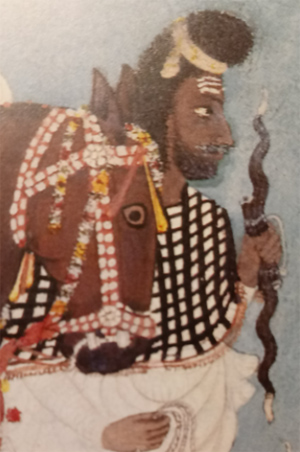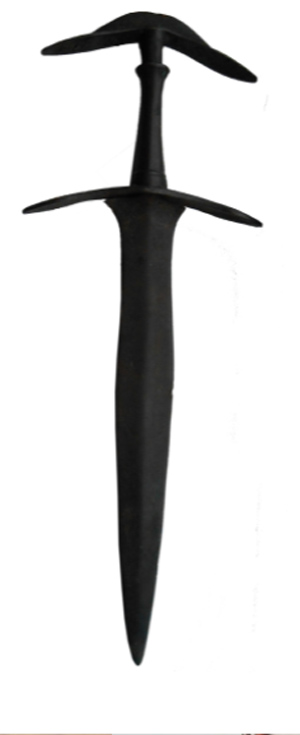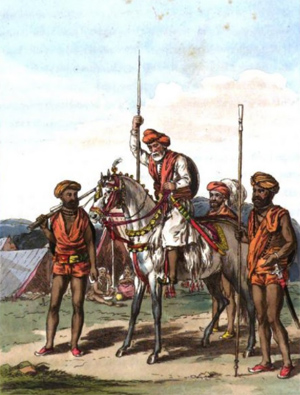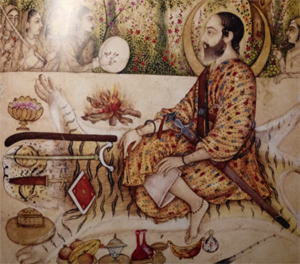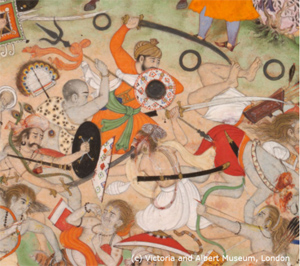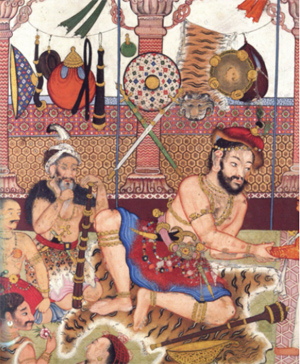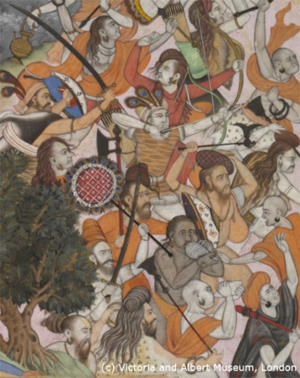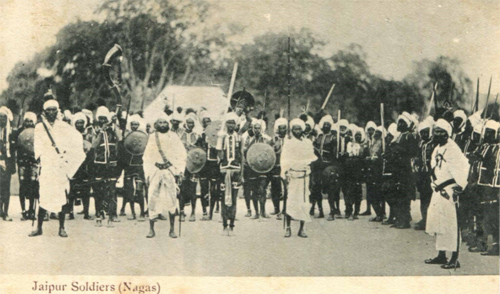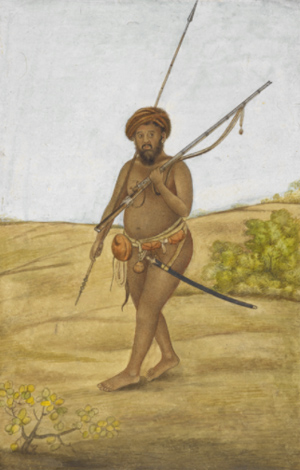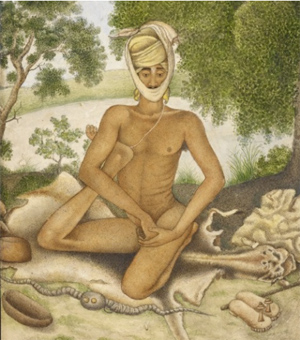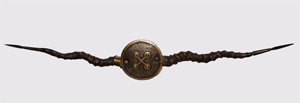by Sten Konow
Epigraphia Indica
1907-8
The slab on which the inscription published below is incised was found during the excavations carried on by Dr. Marshall and myself in Sarnath, in March 1908. It was dug out to the north of the Dhamekh stupa, to the south of the raised mound running east and west over the remnants of the old monasteries of the Gupta period. The writing covers almost the whole of the surface of the stone, viz 21” x 15-1/2”, and it is in a perfect state of preservation. The average size of the letters is ½”.
The characters are Nagari, of a very ornamental type, and the engraving has been done with considerable skill. Of individual letters, the form of the cerebral ta in –bhatah and kandapa-tikah in line 8 is worthy of notice. There are comparatively few orthographical peculiarities. V is used for b throughout, and na is used instead of the anusvara in sudhansos-, line 11. There are some few miswritings such as harmma- for dharma-, 1.6; prakshato for prakhyato, 1.8, vishmayakaro for vismaya- and ashmadprisah for = asmadrisash, 1.13; = nenrabhirama- for –netr-, 1.15, nri- for tri-, 1.22; mahibhujah for mahibhuja, 1.19, etc. The forms Kumaradevi 11.11 and 22, and viharo in 11.23 and 26, on the other hand, are vouched for by the metre Kumara instead of kumara is common in Maharashta Prakrit, and a form Kumaravala for the usual Kumarapala occurs in Hemachandra’s Desnanamala, 1.101, 88.1 [See Pischel, Grammatik der Prakrit-Sprachen, § 81. ] And vihara instead of vihara is justified by Panini VI, 3.122.
The language is Sanskrit, and, with the exception of the invocation to Vasudhara in 1 1, the whole of the inscription is in verse. There are altogether twenty-six verses. Of these thirteen (Nos. 3, 5, 6, 7, 11, 12, 13, 17, 18, 19, 21, 23 and 24) are in the Sardulavikridita, five (Nos. 1, 10, 14, 15 and 20) in the Malini, four (Nos. 4, 16, 22 and 25) in the Vasantatilaka, three (Nos. 8, 9 and 26) in the Anushtubh, and one (No. 2) in the [illegible] metre.
The object of the inscription is to record the construction of a vihara by Kumaradevi, one of the queens of Govindachandra of Kanauj. The wording of verses 21 23, in which her gift is mentioned, is not quite clear. Rai Bahadur V Venkayva has suggested the following explanation, which I think is a very plausible one. Jambuka drew up a copper plate, in which she represented to Kumaradevi that the Dharmachakra-Jina originally set up by Dharmasoka required to be repaired or set up again. This copper-plate must have contained information about the original setting up of the Dharmachakra Jina and further details about its maintenance and repairs. Kumaradevi, who was apparently a stranger to the country round Benares, accepted her representation and raised her to the rank of “the foremost of puttatikas.’2 [Pattalika is the feminine form of pattalaka, which occurs in the Buguda plates of Madhavavarman, above. Vol. III, p. 44, 1.88, in connexion with vaisvdsika.] Moreover, she restored the Jina or set up a new one and placed it in the vihara built for Vasudhara, or in another one constructed for the purpose, and the wish is expressed that, after having been placed there, he may remain there for ever. It seems necessary to infer that the Sridharmachakra Jina, which is said to have existed in Dharmasoka’s time, was an image of the Buddha, and that the vihara built by the orders of Queen Kumaradevi for him, was a shrine, a gandhakuti. It is difficult to explain the wish that he, [illegible] the image, may reside there for ever, under any other supposition.
The inscription can be divided into four parts. After an invocation of Vasudhara (v.1.) and the moon (v.2) vv. 3-6 give some information about some rulers or generals of Pithi or Pithika. We learn that, in the lunar race, there arose a chief called Vallabharaja, the lord of broad Pithika (v.3). The following verse introduces the lord of Pithi Devarakshita, without saying anything about his relationship to Vallabharaja. He is described as the full moon of the lotus of the Chhikkora-vamsa, and we are told that he even surpassed Gajapati in splendor. Devarakshita is again referred to as the lord of Pithi in the second part of the inscription, and it therefore seems necessary to interpret vv. 5-6, which apparently refer to a son of his (tasmad-asa, etc.) as an explanation of his relationship to Vallabharaja, who would then be his father.
The second part of the inscription vv. 7-13, contains the information that Devarakshita was defeated by Mahana, the maternal uncle of the Gauda king, who thus firmly established the throne of Ramapala, and subsequently bestowed his daughter Sankaradevi on the Pithi lord. Their daughter was Kumaradevi, in whose praise the present inscription was written.
The third part, vv. 14-20, then contains the genealogy of the Gahadavala family, to which Kumaradevi’s husband Govindachandra belonged. It agrees with the list given in most inscriptions of this latter king, but does not carry us further back than to his grandfather. We are first introduced to Chandra, the Chandradeva of Govindachandra’s inscriptions. His son was Madanachandra, elsewhere known as Madanapala, who again was the father of Govindachandra. He is said to have saved Benares from the wicked Turushka soldier.
The fourth part of the inscription (verses 21-23) specifies the gifts of Kumaradevi, and her praise is sung in verse 21 Verses 25-26 then inform us that the inscription, which is here called a prasasta, was composed by the poet sri Kunda, and engraved by Vamana.
Govindachandra is the well-known king of Kanauj, whose inscriptions are dated between A.D. 1114 and 1154. Our inscription teaches us that he guarded Benares against the Turnshkas, i.e. the Muhammadans. We do not know of any Muhammadan expedition against Benares in Govindachandra’s time. In A.D. 1033 a Muhammadan army under Ahmad Nialtigin arrived at the town, but only stayed there for a day,1 [See H.M. Elliot, The History of India as told by its own Historians, Vol. II 1869, pp. 112 and ff.] and there is no indication of a permanent settlement. We know, on the other hand, that Mussalman settlers remained in the country about the Jamna from the days of Mahmud and down to the end of the 12th century.2 [Ibid, pp. 250 and ff.] It seems probable that Govindachandra took some action against such settlers, and the term turushkadanda, which occurs in many of his and his predecessors’ inscriptions, gives us a hint as to the nature of this action. The work turushkadanda has been variously translated as “tax on aromatic reeds” and “Muhammadan amercements”.3 [See Fuhrer, Journal Bengal Society, Vol. LVI, Pt. I, p. 113.] The information furnished by our inscription seems to show that it was in reality a tax on Muhammadans, the exact nature of which cannot, however, be determined.
Our inscription introduces us to a new queen of Govindachandra, Kumaradevi, the grand-daughter of Mahana. Three other queens are already known from inscriptions, viz Nayanakelidevi,4 [Above, Vol. IV, p. 108.] Gosaladevi5 [Kielhorn, Northern List, Nos. 127 and 131.] and Dalhanadevi6 [See Fuhrer, loc. cit. p. 115, 119.]. While Govindachandra was himself an orthodox Hindu, his fourth wife Kumaradevi was a Buddhist. According to information kindly supplied by Mahamahopadhyaya Hara Prasad Sastri, the king had still another Buddhist wife Vasantadevi, who is mentioned in the colophon of a manuscript of the Ashtasahasrika in the Nepal Darbar Library (No. 381 of the third collection). The colophon runs –sri-sri-Kanyakubj-adhipaty-asvapta gajapati-narapata-rujya-trayddhipati-srimad-Govindachandradevasya pratapavasatah rajni-sri-pravara-Mahayana-yayinyah paramopasika-rajni-Vasantadevya deyadharmmo=yam.
It is possible that Vasantadevi and Kumaradevi are one and the same person, one of the meanings of vasanta being “youth” = kumara. It is, however, more probable that they are two different persons.
Some information about Mahana, the father of Kumaradevi’s mother, and about the lord of Pithi, her father, can be gleaned from Sadhyakara Nandi’s Ramacharita, which work has been brought to light by Mahamahopadhyaya Hara Prasad Sastri.7 [Proceedings of the Asiatic Society of Bengal, 1900, pp. 70 and ff.] We are there told that Mahana was the maternal uncle of the Gauda king Ramapala. Vigrahapala, the father of Ramapala, made a successful war against the Chedi king Karna of Dahala, of whom we possess an inscription dated Kalachuri Samvat 493=A.D. 1042.8 [Kielhorn, Northern List, No. 407.] Karna’s reign probably extended over a long period.9 [See Kielhorn, above, Vol. II, pp. 302 and ff.] We cannot, therefore, determine when the war against Vigrahapala took place. We have an inscription of the time of Vigrahapala’s grandfather Mahipala, dated A.D. 1026,10 [Kielhorn, Northern List, No. 59.] and Mahipala’s son Nayapala reigned at least 15 years.11 [Ibid., No. 642.] Vigrahapala’s accession cannot, therefore, be placed earlier than A.D. 1041. His son Ramapala, who was preceded on the throne by two brothers Mahipala II and Surapala, was a contemporary of Sankaradevi, the mother of Govindachandra’s queen Kumaradevi. It therefore seems probable that Vigrahapala’s accession should be placed about A.D. 1050, and Ramapala’s reign in the last part of the eleventh century. Mahana, Sankaradevi’s father, would then be a contemporary of both of them. The Ramacharita, which calls him Mathana or Mahana, states that he was a Rashtrakuta, and the maternal uncle of Ramapala. It therefore becomes probable that Vigrahapala married a Rashtrakuta princess in addition to the daughter of the Chedi king Karna who was, according to the Ramacharita, given to him after the war allued to above. Mahana was Ramapala’s right hand, and was of great assistance in the war against Bhima. Among the feudatories of the Pala king in that war, the Ramacharita mentions Viraguna, the raja of Pithi who is described as the lord of the south. Devarakshita of Pithi is also mentioned, but not as a feudatory. He must be identical with the Devarakshita of our inscription, and it becomes probable that the Pithi ruler Viraguna had originally stood on Ramapala’s side, while Devarakshita later on rose against him. He hailed from Pithi or pithika is synonymous with pitha, and it is therefore possible that Pithi is identical with Pithapuram.1 [Compare the forms Pithapura and Pithapuri, above, Vol. IV, p. 37, 357. Note 4.] We know that a branch of the Eastern Chalukyas reigned in Pithapuram in the second half of the twelfth century, and that the town had already been conquered by Pulihosin II. No historical information is forthcoming about the earlier Chalukya princes of the Pithapuram branch. The real history of the family only seems to begin with Vijayaditya III, whose coronation took place A.D. 1158.2 [See Hultzach, above, Vol. IV., p. 223.] It should also be noted that the genealogy given in the Pithapuram inscriptions hardly can be correct. Mr. Sewell has drawn my attention to the fact that only four generations are enumerated between Beta, who reigned in A.D. 925, and Vijayaditya III., who was crowned in A.D. 1158.
Before this branch became established in Pithapuram, the place was one of the strongholds of the Vengi province of the Eastern Chalukyas. In the last part of the 11th century, the reigning king was Kulottunga Chodadeva, who first was ruler in Vengi but who in A.D. 1070 was anointed to the Choda kingdom. Vengi was then ruled by viceroys, first by his uncle Vijayaditya VII then by his sons Rajaraja (1077-78) and Vira Choda (from 1078). Mr. Venkayya suggests that this latter viceroy may be identical with the Viraguna of the Ramapalacharita. Devarakshita was then probably a general under the viceroy of Vengi. He is said to have surpassed even the glory of Gajapati. As this epithet is used by some of the Eastern Gangas, it is possible that it here refers to Anantavarma Chodagana. The Kalingattu Parani3 [Ind. Ant. Vol. XIX., p. 329 ff.] describes an expedition undertaken by Kulottunga I. against this king, and Devarakshita may have played a role in it. We do not know anything about the Chhikkora family, to which Devarakshita belonged.
The marriage of Devarakshita’s daughter to king Govindachandra perhaps accounts for the relationship between the Cholas and the Gahadavalas commented on by Mr. Venkayya in his Annual Report for 1907-08, para. 58 and ff. An incomplete Gahadavala inscription has recently been found immediately after a record of Kulottungadeva of A.D. 1110-11, in Gangarkonda cholapuram, which it is tempting to bring into connexion with Govindachandra’s marriage. Mr. Venkayya carries the acquaintance of the Gahadavalas with the Choja kings further back to the expedition of Rajendra Chola towards the kings on the banks of the Ganges, mentioned in the Tiruvalangadu plates, and it seems very probable that this expedition led to the establishment of friendly relations with the north. Among the princes conquered by Rajendra Chola was Dharmapala of Dandabhukti, and the lord of Dandabhukti figures amongst the feudatory kings who, according to the Ramapalacharita, assisted Ramapala in his war against Bhima.
The relationship between the various persons mentioned in our inscription will be seen from the table which follows:

According to verse 25, the inscription was composed by Kunda, who describes himself as a lion to the tirthika-elephants, a Rohana mountain, full of the splendid gems of poetical composition, a poet in eight bhashas, and an intimate friend of the king of Vanga. He is not elsewhere known. His name does not occur in the Saduktikarnamrita,1 [Rajendra Lala Mitra’s Notices of Sanskrit Manuscripts, Vol. II, p. 134 and ff.] nor, so far as I know, in any other anthology. The engraver was the silpin Vamana.
TEXT

SARNATH INSCRIPTION OF KUMARADEVI
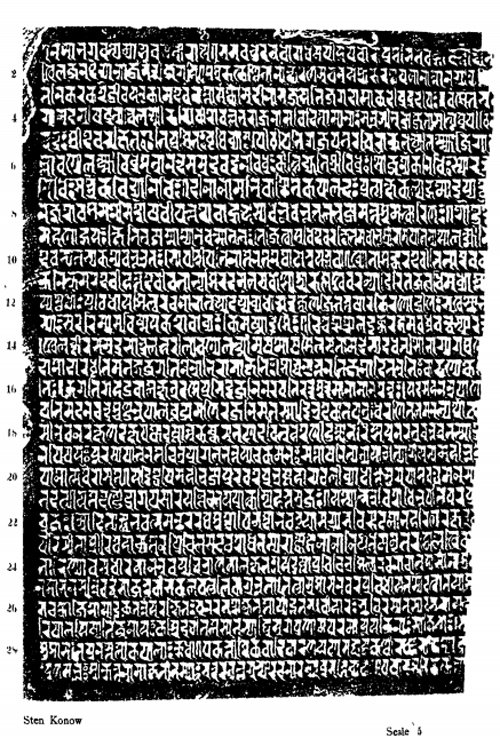
TRANSLATION
Hail. Obeisance to the exalted noble Vasudhara.
(V.1) May Vasudhara protect the worlds, who abates the broad stream of unlimited misery in the manifold universe by the nectar stream of dharma, who pours out riches of wealth and gold over earth, skies and heaven, and who conquers all the misery of man in them2 [Mr. Venkayya suggests to read dainydi-tydjayanii.]
(V.2) Victorious be that lover of the lotuses, the flashing torch for the illumination of the world, who causes oozing of the lovely moon-gems and (brings tears into) the eyes of longing people; who opens the knot of pride in haughty damsels and also the closed lotuses, who with his nectar-filled beams revives the god of love, who was burnt to ashes by Tavara, (who had been) smitten (by him).
(V. 3) In his (the moon’s) lineage, which enjoys a valour worthy of homage; which is resplendent with shining fame, which speedily annihilates the pride of the river of the gods by its purity, which destroys the splendor of its adversaries, was a hero, known by the name of Vallabharaja, honoured among princes, the victorious lord of broad Pithika, of increasing mighty prowess.
(Vv. 4-5) The full moon expanding the lotuses of the Chhikkora family, known on earth as sri-Devarakshita, the lord of Pithi (who) surpassed even the splendor of Gajapati by his splendor, whose glory alone ravished the hearts of the world, was descended from him (Vallabharaja), as the moon from the ocean, a (veritable) Vishnu (Vidhu), to the Lakshmi of beauty, a (veritable) moon in causing the rise of the ocean, viz ocular pleasure (as the moon raises the ocean); a second moon, the luster of whose light was his fame (or, a second Vishnu with Sri in the shape of the luster of his fame), an incomparable treasure of goodness, a treasure of resplendent virtues; an ocean of profundity; a peerless store of religion, a store of energy, the only depository of the lore of arms, --
(V.6) Who was the veritable celestial tree in bestowing desired objects on supplicants, who was an irresistible thunderbolt in accomplishing the splitting of the mighty mountains, viz. his haughty foes, a marvelous man, whose arm was like a sprout of a marvelous herb in healing the fever of Cupid in enamoured women, and death to kings.
(V.7.) In the Gauda country there was a peerless warrior, with his quiver,3 [The meaning of kandapatika is uncertain. The word is usually translated ‘screen.” But this meaning [lines missing]] this incomparable diadem of kshatriyas, the Anga king Mahana, the venerable maternal uncle of kings. He conquered Devarakshita in war and maintained the glory of Ramapala, which rose in splendor because the obstruction caused by his foes was removed.
Foremost among Ramapala’s allies was his maternal uncle Mathana, better known as Mahana, the Rastrakuta chief who joined Ramapala with his two sons, Mahamandalika Kanharadeva and Suvarnadeva, and his brother’s son Mahapratihara Sivaraja. Mathana had already established his fame by defeating Devaraksita, king of Pithi. This statement in RC is fully supported by the following passage of the Saranath inscription. “In the Gauda country there was a peerless warrior, the Anga king Mahana, the venerable maternal uncle of kings. He conquered Devaraksita in war and maintained the glory of Ramapala, which rose in splendour because the obstruction caused by his foes was removed.”1 [Ep. Ind. Vol. IX, p. 386 [Actually pp. 320-326].]
-- The Ramacaritam of Sandhyakaranandin, by Dr. R. C. Majumdar, M.A., Ph.D.; Dr. Radhagovinda Basak, M.A., Ph.D.; andPandit Nanigopal Banerji, Kavyatirtha
(V.8.) The daughter of this Mahanadeva was like the daughter of the mountain (i.e. Parvati), she was married to the lord of Pithi as (Parvati) to Svayambhu;
(V.9.) She was known as Sankaradevi, full of mercy like Tara, and she excelled the creepers of the wishing tree in her efforts to make gifts.
(V.10.) To them, forsooth, was born Kumaradevi, like a devi, lovely like the charming streak of the spotless autumnal moon, as if Tarini herself, prompted by compassion, had descended to earth with a wish to free the world from the ocean of misery.
(V.11.) After having created her, Brahma was filled with pride at his own cleverness in applying his art, excelled by her face the moon, being ashamed, remains in the air, rises at night becomes impure and subsequently full of spots, how can this her marvelous beauty be described by people like us?
(V.12.) She, who in a wonderful way possesses a beautiful body, which is a glittering net for entrapping female antelopes, viz. the moving eyes, and which robs the wealth of beauty of the lense waves of the playful milky ocean by her brilliant charm of lovely splendor; who does sway with the infatuation of the daughter of the mountain (i.e. Parvati) by her proud grace.
(V.13.) Her mind was set on religion alone, her desire was bent on virtues, she had undertaken to lay in a store of merit, she found a noble satisfaction in bestowing gifts, her gait was like that of an elephant, her appearance charming to the eye, she bowed down to the Buddha, and the people sang her praise, she took her stand in the play of commiseration, was the permanent abode of luck, annihilated sin, and took her pride in abundant virtue.
(V.14.) In the royal Gahadavala lineage, famous in the world, was born a king, Chandra by name, a moon (Chandra) among rulers. By the streams of tears of the wives of the kings who could not resist him, the water of the Yamuna forsooth became darker.
(V.15.) The king Madanachandra, a crest jewel amongst impetuous kings, was born from him, the lord who brought the circle of the earth under one scepter, the splendor of the fire of his valor being great and mighty, and who even lowered the glory of Maghavan by his glory.
(V.16.) Hari, who had been commissioned by Hara in order to protect Varanasi from the wicked Turushka warrior, as the only one who was able to protect the earth, was again born from him, his name being renowned as Govindachandra.
(V.17.) Wonderful, the calfs of the celestial cows could not formerly get even drops of the milk stream to drink, on account of its continuous use for satisfying the hearts of supplicants, but after the multitude of these supplicants had been gladdened through the liberality of that king, they sat down to the feast of drinking the milk which is always plentiful and applied according to their wishes.
(V.18.) In the excellent cities of his adversaries, hunters by mistake do not pick up fallen necklaces, thinking them to be nooses for the deer in it, and hunters quickly remove the fallen gold ear-ring with sticks, the garlands in their hands shaking with fear, mistaking it for a snake on account of its large size.
(V.19.) The chariot of the sun was delayed because its span of horses were greedy after the mouthful of fresh, shining, thick grass on the roofs of the palaces in the towns of his uprooted foes, and also the moon became slow, because he had to protect the gazelle (in his orb), which was falling down, having become covetous after the grass.
(V.20.) Kumaradevi, forsooth, was famous with that king, like Sri with Vishnu, and her praises were sung in the three worlds, and in the splendid harem of that king, she was indeed like the streak of the moon amongst the stars.
(V.21.) This vihara, an ornament to the earth, the round of which consists of nine segments, was made by her, and decorated as it were by Vasudhara herself in the shape of Tarini, and even the creator himself was taken with wonder when he saw it accomplished with the highest skill in the applying of wonderful arts and looking handsome with (the images of) gods.
(V.22.) Having prepared that copper-plate grant, which recorded the gift to sri-Dharma chakra Jina, for so long a time as moon and sun endure on earth, and having given it to her, that Jambuki was made (?) the foremost of all pattalikas by her (Kumaradevi).
(V.23.) This Lord of the Turning of the Wheel was restored by her in accordance with the way in which he existed in the days of Dharmasoka, the ruler of men, and even more wonderfully, and this vihara for that [illegible] was elaborated erected by her, and might be placed there, stay there as long as moon and sun ([illegible]).
(V.24.) If anyone on the surface of the world preserves her fame, she will be intent on bowing down at his pair of feet. You Jinas shall be witnesses. But if any fool robs her fame, then those lokapalas will quickly punish that wicked man in their wrath.
(V.25.) The poet in eight bhashas known as the trusted friend of the Banga-king, Sri-Kuna by name, the learned who was the only hon to attack the crowds of the elephant like heretics, who was a Rohana mountain of the flashing jewels of poetical composition, he made this eulogy of her, charming with strings of letters beautifully arranged.
(V.26.) This prasasta has been engraved by the [illegible] Vamana on this excellent stone which rivals the rajavarta (i.e. Lapis Lazuli).

